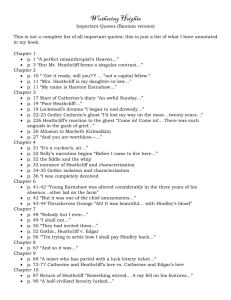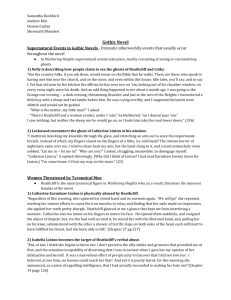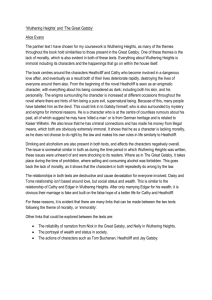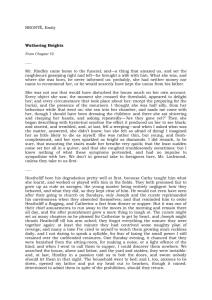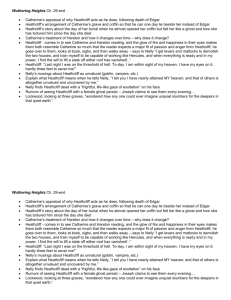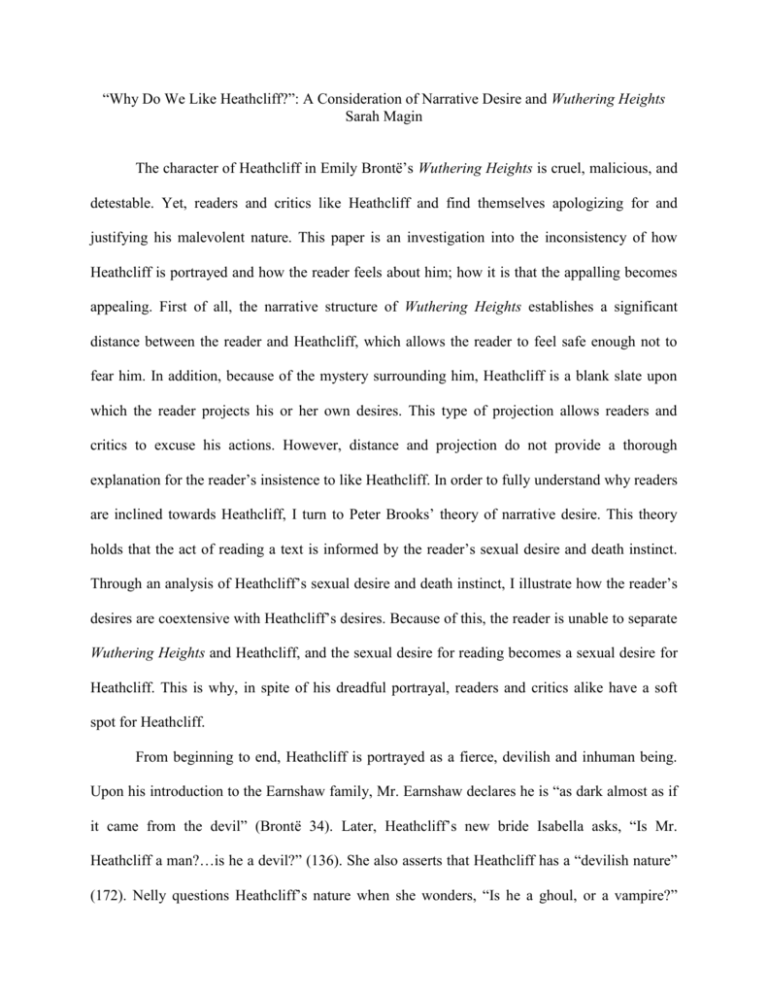
“Why Do We Like Heathcliff?”: A Consideration of Narrative Desire and Wuthering Heights
Sarah Magin
The character of Heathcliff in Emily Brontë’s Wuthering Heights is cruel, malicious, and
detestable. Yet, readers and critics like Heathcliff and find themselves apologizing for and
justifying his malevolent nature. This paper is an investigation into the inconsistency of how
Heathcliff is portrayed and how the reader feels about him; how it is that the appalling becomes
appealing. First of all, the narrative structure of Wuthering Heights establishes a significant
distance between the reader and Heathcliff, which allows the reader to feel safe enough not to
fear him. In addition, because of the mystery surrounding him, Heathcliff is a blank slate upon
which the reader projects his or her own desires. This type of projection allows readers and
critics to excuse his actions. However, distance and projection do not provide a thorough
explanation for the reader’s insistence to like Heathcliff. In order to fully understand why readers
are inclined towards Heathcliff, I turn to Peter Brooks’ theory of narrative desire. This theory
holds that the act of reading a text is informed by the reader’s sexual desire and death instinct.
Through an analysis of Heathcliff’s sexual desire and death instinct, I illustrate how the reader’s
desires are coextensive with Heathcliff’s desires. Because of this, the reader is unable to separate
Wuthering Heights and Heathcliff, and the sexual desire for reading becomes a sexual desire for
Heathcliff. This is why, in spite of his dreadful portrayal, readers and critics alike have a soft
spot for Heathcliff.
From beginning to end, Heathcliff is portrayed as a fierce, devilish and inhuman being.
Upon his introduction to the Earnshaw family, Mr. Earnshaw declares he is “as dark almost as if
it came from the devil” (Brontë 34). Later, Heathcliff’s new bride Isabella asks, “Is Mr.
Heathcliff a man?…is he a devil?” (136). She also asserts that Heathcliff has a “devilish nature”
(172). Nelly questions Heathcliff’s nature when she wonders, “Is he a ghoul, or a vampire?”
2
(330). At other points in this text, he is referred to as a “hellish villain” (138, 175), “Judas”
(111), “diabolical” (179), “that devil Heathcliff” (286), “a wicked man” (239), a “ruffian” (274),
and “a fierce, pitiless, wolfish man” (102). At Heathcliff’s death, Joseph thanks the lord and
cries, “Th’ divil’s harried off his soul” (335). To say the least, Heathcliff is clearly described as a
deplorable character.
Throughout this book, Heathcliff commits horrible acts and displays despicable behavior.
When Heathcliff accidentally saves Hareton’s life, he expresses “intense anguish” and regrets
that he did not assist Hareton’s death (74). Before running off with Isabella, Heathcliff leaves
Isabella’s dog hanging “suspended to a handkerchief” (129). Heathcliff then marries Isabella, not
for love, but in order to “provoke Edgar to desperation” (152). He makes Isabella miserable
through his unkindness and ultimately “snatched a dinner knife from the table and flung it” at her
head (181). Heathcliff is also responsible for the death of Hindley, but not before he has conned
Hindley out of his money and property. Although Heathcliff denies responsibility, Joseph swears
that Hindley “warn’t deed when Aw left” and only died when alone with Heathcliff (186). In
addition, Heathcliff abuses and beats Hareton down to a “reduced” state (187). Using his son
Linton as bait, Heathcliff traps young Catherine and Nelly in Wuthering Heights. When young
Catherine begs to be released in order to see her dying father, Heathcliff refuses and states, “I
shall enjoy myself remarkably in thinking your father will be miserable” (274). He then forces
young Catherine to marry the dying Linton. As Linton’s condition worsens, Heathcliff refuses to
send for a doctor and declares, “his life is not worth a farthing, and I won’t spend a farthing on
him” (292). Through this neglect, Heathcliff is largely responsible for his own son’s demise.
Furthermore, Heathcliff violates Cathy’s grave twice. This is, by no means, a comprehensive
account of Heathcliff’s malicious disposition; but an attempt to illustrate how his cruelty is both
severe and extensive.
3
As presented, Heathcliff’s actions ought to be enough to prove him “unredeemed,” as
Charlotte Brontë offers in her preface to the 1850 edition of Wuthering Heights (qtd in Drew
368). Yet, the reader’s reaction to Heathcliff is inconsistent with his depiction. Critics and
readers tend to excuse and justify his actions. Each critic seems to supply a new reason to
sympathize with Heathcliff and grant him a saving grace. As Philip Drew questions, “Why, in
short, have critics responded so readily to Heathcliff as the hero of the novel and paid so little
attention to his more conspicuous qualifications to be considered a villain?” (372). Drew fails to
answer this question when he concludes that Heathcliff is “Emily Brontë’s achievement […] to
arouse our sympathy for a lost soul” (380). With this, Drew sympathizes with Heathcliff rather
than delve into an explanation. Edgar F. Shannon provides that “Heathcliff is the victim instead
of the originator of evil” (103) and excuses his brutalities for the reason that “Wrong issues only
from the occlusion of love” (104). For Shannon, Heathcliff’s love for Cathy is his redemption.
Shannon even attempts to lessen Heathcliff’s bad reputation by pointing out his favorable
behavior towards Lockwood. Heathcliff “provides Lockwood with a glass of wine, tea, and
dinner on separate occasions,” “sends him a brace of grouse,” and “chats amiably” with him for
one hour (104). Yet, these niceties are nothing when compared to Heathcliff’s astonishing record
of malevolence. A contemporaneous review of Wuthering Heights emphasizes Heathcliff’s love
for Cathy over his cruel behaviors when it favorably remarks, “The anguish of Heathcliff on the
death of Catherine approaches to sublimity” (The English Novel 196). What is clear is that critics
like Heathcliff and are determined to defend him, even though there is little textual evidence to
support these reactions.
The reader’s affinity for Heathcliff can be partly explained by the narrative structure of
Wuthering Heights. For the structure of this novel distances the reader from the characters. This
story is not told directly to the reader, but through Lockwood’s account of Nelly’s oral rendition.
4
In addition to the distance produced by the dual narration of Mr. Lockwood and Nelly, David
Galef holds that “The written as opposed to the spoken word” is a “method of distancing,” for
“the printed page involves more intermediate steps than does oral articulation” (243). In this
way, the fact that the entirety of Wuthering Heights is told through Lockwood’s journal entries
brings this book even further from the reader. This distance between the reader and the story of
Wuthering Heights entails a distance between the reader and Heathcliff.
The significance of distancing the reader from Heathcliff becomes apparent in John
Fraser’s hold that distance goes hand in hand with safety. “When one is safe from another
person,” as Fraser explains, “it is easy enough to be tolerant of him” (225). This is clear in
Galef’s comparison of Lockwood and Isabella, which notes how Isabella’s reaction to Heathcliff
is more aggressive than that of Lockwood. This is because “Isabella is not allowed to step away
from her crisis, as Lockwood is” (Galef 246). The different amount of distance in the
relationships between Heathcliff and “the bride” Isabella, and Heathcliff and the “tenant”
Lockwood accounts for their diverse responses (Galef 246). As Heathcliff’s wife, Isabella lives
in the same house as Heathcliff and is exposed to his abominable behavior” on a daily basis
(Brontë 181). It is her closeness to Heathcliff that causes her “abhorrence” and fear (145).
Isabella describes her fear of Heathcliff when she writes to Nelly, “a tiger or a venomous serpent
could not rouse terror in me equal to that which he wakens” (145). Lockwood’s more accepting
view of Heathcliff is due to his distance from Heathcliff. As his tenant, Lockwood spends little
time in Heathcliff’s presence and is therefore safe from Heathcliff’s brutality. The only time that
Lockwood remains at Wuthering Heights for more than a couple hours ends with him screaming
angrily at Heathcliff, declaring, “I am now quite cured of seeking pleasure in society” (26). Galef
closes his article by stating that, “only the figure capable of remaining apart, like the artist,
survives” (249). This comment is significant in its proposal that the concept of safety through
5
distance can be applied outside of the text. Fraser also recognizes this potential when he refers to
the “safely distant reader” (233). Not just the other characters, but the reader too benefits from
being distanced from Heathcliff. This is why the reader, like Lockwood, is able to emerge
unscathed; while Isabella is so heavily injured.
But distance only explains why readers don’t fear Heathcliff; not why they make excuses
for his actions. John Allen Stevenson makes claims about the love affair between Heathcliff and
Cathy, which can shed light upon the reader’s relationship with Heathcliff. As Stevenson
provides, Heathcliff’s “opacity is the key” to understanding their love (67). Heathcliff’s opacity
stems from the fact that very little is actually known about him. His background, age and racial
origins are uncertain, and his three-year absence is never even partially explained. Upon both his
introduction to Wuthering Heights and his return, Heathcliff seems to appear out of nowhere. At
his introduction, Mr. Earnshaw produces young Heathcliff out of his “great-coat” (Brontë 34)
and while he “tried to explain the matter” (35), neither Nelly, the Earnshaws, nor readers ever
understand how Heathcliff came to Wuthering Heights. Heathcliff’s return is also mystifying.
When he calls out to Nelly, she is both surprised and frightened because she “had seen nobody
on approaching the steps” (92). She finally sees “Something” in the night’s darkness “moving
nearer,” but is unable to distinguish who it is (92). Finally, “A ray fell on his features” (92) and
Nelly exclaims “What! you come back? Is it really you? Is it?” (93). Even after seeing the face of
a man she has known for years, Nelly still requires his affirmative response to be sure that the
stranger before her is in fact Heathcliff. The mystery surrounding Heathcliff incites numerous
unanswerable questions. The best the other characters or the readers can do is make baseless
speculations and hypothetical guesses.
It is the mystery and uncertainty surrounding Heathcliff that cause him to become, as
Stevenson notes, “a blank screen, ready for Catherine…to fill with an image of [her] own
6
creation” (71-72). What this means is that Cathy projects upon Heathcliff the image of what she
wishes to love. Stevenson notes that Cathy is not the only character who projects upon
Heathcliff; Nelly, Mr. Earnshaw and Isabella respond to “his blankness” as well (Stevenson 71).
Like these other characters, readers too project their own desires onto Heathcliff. It is through
Heathcliff’s own words that this kind of projection is best explained. Although speaking
specifically of Isabella, Heathcliff’s observation “so obstinately has she persisted in forming a
fabulous notion of my character, and acting on the false impressions she cherished” could easily
be applied to the other characters and the readers (Brontë 150). Because there is so much about
Heathcliff that is unknown, the reader is able to form their own version of him that satisfies their
own demands. This conviction also explains the critics’ tendency to form their own sympathetic
images of Heathcliff; for the critic too is a reader that creates and acts upon “a fabulous notion”
of Heathcliff (150).
Yet I hold that there is more than distance and projection that draws the reader to
Heathcliff. As I will soon establish, readers like Heathcliff because they sexually desire him. But
in order to fully understand this connection, one must first understand Peter Brooks’ theory of
narrative desire and how it reveals a parallel between reading and sexual desire.
Brooks builds his theory upon Freud’s discussion of man’s basic instincts, specifically
the pleasure principle and Eros. For our purposes, it is only necessary to understand Freud’s
theories in the most simplistic of terms. The pleasure principle is the force within us that works
for the “ production of pleasure”(Freud 1). Since “the greatest pleasure attainable by us” is “that
of the sexual act,” the pleasure principle is constantly compelling us towards sexual gratification
(86). Eros too is a force that impels us. Although Eros, “the preserver of life,” (73) incorporates
many concerns, it is fundamentally preoccupied with “the sexual instinct” (71). This sexual
instinct of Eros is the sex drive that, like the pleasure principle, causes us to seek sexual
7
satisfaction. What is clear from Freud’s convictions is that he places sexual desire as central to
the forces that drive us. In Brooks’ theory of narrative desire, he takes this belief that sexual
desire guides our actions and applies it specifically to reading. He is essentially using
psychoanalytic theory to give insight into the way readers approach text. Instead of seeing the act
of reading simply as a recreation or an escape from reality, Brooks provides that it is enthused by
sexual desire. As Brooks explains, “Desire is always there at the start of a narrative, often in a
state of initial arousal, often having reached a state of intensity such that movement must be
created, action undertaken, change begun” (38). What this means is that when readers begin a
narrative, there is a sexual charge that impassions them and makes them want to read further. In
this way, narrative desire is the force that drives us to read. Because the desire to read is sexually
based, the very act of reading is a sexual act in which readers are active participants.
If reading is a sexual act, then it is also a seduction. Throughout the entirety of Wuthering
Heights, readers are enthralled and excited by the story, but always anticipating the climax. In
this way, the text holds a type of sexual power over readers. This is clear in the language that we
use to speak about books and reading. To say that you are ‘captivated,’ ‘enchanted’ or
‘mesmerized’ by a text acknowledges that the text is in control over your emotions. Also, the fact
that such phrases as ‘nineteenth-century literature is my passion,’ ‘I adore this book’ or ‘I’m in
love with Emily Brontë’ are easily understood reveals how narrative is largely accepted as a
seductress. The ease with which such metaphors of love and sexuality are applied to books also
indicates how apt Brooks’ theory really is. Because Wuthering Heights is essentially the story of
Heathcliff, readers are being seduced by the story of Heathcliff. The way in which Wuthering
Heights is the story of Heathcliff is clear in the plot structure of this work, which begins with his
arrival and ends with his death. Also, as Anne Williams acknowledges, “Heathcliff is the only
character in Wuthering Heights […] who is prominent in both halves of the narrative” (116).
8
Because this book is so centered on Heathcliff, the readers’ seduction belongs entirely to
Heathcliff.
In order to fully comprehend Brooks’ theory of narrative desire, we must once again turn
to Freud’s discussion of Eros. Eros, which Brooks uses as a basis for narrative desire, is
“subtended by the death instinct, the drive of living matter to return to the quiescence of the
inorganic, a state prior to life” (Brooks 51). What this means is that the death instinct, man’s
desire for death, is connected with man’s sexual desires. In this way, the forces that drive us are
based not only upon sexual desire, but also the desire for death. As Freud declares, “the aim of
all life is death” (qtd in Brooks 102). In Brooks’ application of Freud to text, the desire for death
becomes a “desire for the end, for that recognition which is the moment of the death of the reader
in the text” (Brooks 108). This is clear in reading Wuthering Heights, where readers anxiously
await the novel’s conclusion. What is significant is that readers want the book to end. The desire
for the end is dependent upon readers’ desire for meaning and understanding. Brooks relies upon
Walter Benjamin’s hold that “only the end can finally determine meaning” (22) to make his point
that the reader’s desire for meaning is “ultimately, inexorably, desire for the end” (52). The way
in which death and the end are interconnected is clear in Wuthering Heights, where the end of the
text is the death of both the reader and Heathcliff. With this, Brooks introduces another
complexity to narrative desire, which is informed by both sexual desire and the death instinct.
For the sake of a proper understanding of narrative desire, it is important to clarify that sexual
desire and the death instinct are more than two facets of a larger concept. They are parallels that
serve each other in a way that makes their aim, or culmination, impossible to separate (107).
What this indicates is that reading a text, sexual desire, and the death instinct are all inextricably
connected in literature.
9
Another important aspect of narrative desire is that the reader’s desire for the end is a
desire for “the right death, the correct end” (103). This is because, as Freud says, “the organism
wishes to die only in its own fashion” (qtd in Brooks 102). Readers’ desire for the end must be
achieved only in the correct way, and the end is not correct if it comes too quickly, or in the
improper manner. The correct ending takes time. If the end is not properly developed over time,
then it will “short-circuit,” and be unsatisfying to the reader (Brooks 102). For example, an
improper ending in Wuthering Heights would be if Heathcliff kills himself the night of Cathy’s
death. Heathcliff must only die and the story must only end eighteen years later. It is for the sake
of the correct end that “fulfillment must be delayed so that we can understand it in relation to
origin and to desire itself” (111). The idea that the proper end must be developed and achieved
over time further illustrates the parallels between reading, sex, and death because all of these
benefit from “a pleasuring in and from delay” (103). A pleasuring from delay exists in the
structure of Wuthering Heights, which features an eighteen-year-long subplot about young
Catherine. As Brooks provides, “The subplot stands as one means of […] assuring that the main
plot will continue through to the right end” (104). Any ending prior to this subplot would simply
not work because both the death of Heathcliff and the end of the text must be delayed until they
can be properly culminated.
A consideration of Wuthering Heights in regard to narrative desire is especially profitable
because it helps to explain the presence and importance of young Catherine’s subplot. Critics,
such as William R. Goetz, are committed to discerning the relation between the story of Cathy
and Heathcliff, and young Catherine and Linton. In his attempt, Goetz breaks this novel into two
halves and analyzes the second half as an adulteration, repetition and correction (Goetz). What
Goetz fails to understand is how the second half is actually a subplot that fosters and necessitates
the main plot’s conclusion. This conclusion does not lessen the importance of this subplot; in
10
fact, it elevates this part of the novel by revealing it to be essential to both the text as a whole and
the fulfillment of readers.
The connection between the readers’ sexual desire and death instinct is coextensive with
Heathcliff, whose sexual desire is strangely linked with his desire for death. Heathcliff and
Cathy’s love is unworldly and impossible to achieve in life. Therefore, Heathcliff looks towards
his death as the fulfillment of both his sexual desires and the death instinct. This is why, when
Heathcliff tells Nelly “I have a single wish” and that “I am swallowed in the anticipation of its
fulfillment,” he makes no attempt to clarify whether he is talking about his approaching death or
his desires for Cathy (Brontë 325). For Heathcliff, these two desires are so dependent upon each
other that they are united as one wish. The unification of these desires is also apparent in
Heathcliff’s statement that he dreams “of dissolving with her” (289). Heathcliff’s wish to
dissolve with Cathy is not merely a metaphorical declaration; he bribes the sexton to tear out the
barriers between his and Cathy’s coffins to allow them to decompose together. This intent to
dissolve with Cathy is the coming together of two bodies in an act that is both sexual and the
death instinct’s drive to return to the inorganic state prior to life. Heathcliff again stresses the
importance of dissolving with Cathy the night of his death when he tells Nelly “to notice that the
sexton obeys my directions concerning the two coffins!” (334). What is clear is that, like the
reader, Heathcliff’s sexual desire and death instinct are dependent upon each other.
The union between Heathcliff’s sexual desire and desire for death can also be seen in the
infamous ‘Mad scene.’ In this scene, Heathcliff and Cathy are together for the last time in life.
Cathy suffers from a terminal illness and is described as having a “white cheek, and a bloodless
lip” (159). The “paleness of her face” causes Nelly to recognize her as “one doomed to decay”
(156). Nelly reiterates the fact that Cathy is clearly dying when she says of Heathcliff, “The same
conviction had stricken him as me, from the instant he beheld her, that there was no prospect of
11
ultimate recovery there—she was fated, sure to die” (158). At times during this scene Nelly is
unable to even determine whether or not Cathy is conscious or if she is alive. In addition to
Cathy’s “haggard” expression, Nelly remarks that Cathy’s eyes “appeared always to gaze
beyond, and far beyond—you would have said out of this world” (156). Though alive, Cathy is
already in contact with the realm of the dead. And yet, this is the most sexually charged
interaction between Heathcliff and Cathy. Heathcliff responds to Cathy’s lifeless and pale body
with “frantic caresses” (161) and he “bestowed more kisses than ever he gave in his life before”
(158). This scene is full of kisses, wild embraces, and declarations of passion. At one point, it is
described that Heathcliff’s “breast heaved convulsively” and then, in a curious manner that Nelly
“hardly saw,” they were suddenly “locked in an embrace” from which Nelly feared Cathy
“would never be released alive” (160). The heightened sexuality of this moment is even more
apparent when one takes into account that the verb ‘to die’ has an alternate meaning, “To
experience a sexual orgasm” (OED). With this, Nelly’s comment that Heathcliff and Cathy’s
ambiguous physical union might cause Cathy to die assumes a more sexualized meaning.
Through this scene, Heathcliff’s sexual passion for the dying Cathy further illustrates how his
desire for sex is informed by a desire for death. Only when she is at death’s door is Heathcliff
able to express his sexual desire for Cathy. What is crucial about this scene is that Heathcliff’s
sexual desire and death instinct remain unfulfilled. These desires can only be properly satisfied
in death, when he will finally be able to dissolve with Cathy.
After Cathy’s death, Heathcliff violates her grave at two different times; the night of her
burial, and then again eighteen years later. What is significant is that these violations are
Heathcliff’s aborted attempts to satisfy his sexual desire and death instinct too early. On the night
of Cathy’s burial, Heathcliff “got a spade from the toolhouse,” dug up Cathy’s grave, and then
“fell to work with my hands” (Brontë 289). As he gets closer to Cathy’s body, he casts aside his
12
man-made tool and moves towards a physical connection with her body. As he describes, “the
wood commenced cracking about the screws” and, just when he was “on the point of attaining
my object,” he felt a presence and stopped (289). Then, Heathcliff provides, “I felt that Cathy
was there, not under me, but on earth” (290). At this moment, there exists “a turning back from
immediate pleasure” for the sake of the correct end (Brooks 101). For Heathcliff is not yet able
to satiate his desires. As with the “mad scene,” Heathcliff’s desires are frustrated to ensure the
proper culmination.
The second violation occurs eighteen years later, shortly before Heathcliff’s death. While
the sexton is digging another grave, Heathcliff gets him “to remove the earth off her coffin lid,”
and then Heathcliff “opened it” (Brontë 288). Heathcliff describes that, “I thought, once, I would
have stayed there, when I saw her face again” (288). When he accounts that he used to think that
he would remain with Cathy, Heathcliff is affirming his desire to come into a physical union
with Cathy’s dead body. His use of the past tense illustrates his recognition that this desires will
not be satisfied at the moment. Like with his previous violation of Cathy’s grave, Heathcliff must
wait for the correct fulfillment.
Also important to consider is Heathcliff’s relationship with Cathy’s ghost. When
Heathcliff declares that Cathy “has disturbed me, night and day, through eighteen years,” (289)
he is saying that Cathy has answered his plea to “haunt me” (167). Since Cathy’s death,
Heathcliff has maintained a strange kind of relationship with Cathy’s ghost. The reader doesn’t
find out about this relationship until just before Heathcliff’s death and even then very little
information is provided. The sexual dynamics of this relationship become clear when Nelly
overhears Heathcliff uttering, “the name of Catherine, coupled with some wild term of
endearment” (332). When she comments that he was speaking “as one would speak to a person
present,” it is understood that Heathcliff is offering his affections to Cathy’s ghost (332). Also,
13
Heathcliff tells Nelly that, “when I slept in her chamber,” Cathy would sometimes be present
“resting her darling head on the same pillow as she did when a child” (290). Essentially,
Heathcliff would lie in Cathy’s bed and experience her ghost in bed with him. Furthermore,
Heathcliff’s relationship with Cathy’s ghost is analogous to a seduction. As Heathcliff describes,
“I could almost see her, and yet I could not! I ought to have sweat blood then, from the anguish
of my yearning, from the fervour of my supplications to have but one glimpse!” (290). Through
her spiritual presence, Cathy’s ghost would arouse and tease Heathcliff, but never satisfy him
with her physical presence. What is important to recognize is that it is only through a physical
presence that Heathcliff would be able to touch Cathy and satiate his sexual desires. In this way,
Heathcliff’s desire to see Cathy spoke to his desire to touch and have sex with her. Heathcliff’s
assertion that “since then, sometimes more, sometimes less, I’ve been the sport of that intolerable
torture!” reveals that this type of seduction has been constant in his relationship with Cathy’s
ghost (290). For eighteen years, Heathcliff has been involved in an enduring arousal and
frustration of sexual desire for Cathy’s ghost. Like readers, the culmination of Heathcliff’s
sexual desire and death instinct is delayed throughout Wuthering Heights’ eighteen-year subplot
in order to allow the proper ending. This proper ending occurs in Wuthering Heights’ closing
image of Heathcliff and Cathy’s grave, where Heathcliff is at long last able to dissolve with
Cathy.
Throughout this discussion, I have illustrated how Heathcliff contends with the same
desires as the readers who read this text. First of all, like the readers, Heathcliff possesses both
sexual desire and the death instinct. Also, the aims of both of these desires are dependent upon
and serve each other. Attempts at the premature fulfillment of these desires must be frustrated in
order to allow the proper end. In addition, this proper end is specifically delayed by the eighteenyear subplot. In this way, it is only through the consideration of narrative desire that the unique
14
relationship between the reader and Heathcliff can be understood. In the act of reading
Wuthering Heights, readers experience the same interaction between sexual desire and the death
instinct that Heathcliff himself experiences within the text. Because Heathcliff is such a perfect
representation of narrative desire within Wuthering Heights, readers are unable to separate the
book from Heathcliff, thus allowing the readers’ experience of both Wuthering Heights and of
Heathcliff to be identical. Since the readers are unable to separate Wuthering Heights from
Heathcliff, the sexual desire for reading is a sexual desire for Heathcliff. In this way, the
narrative of Wuthering Heights is a seductress in the same way that Heathcliff is a seducer.
Because the readers’ sexual desires are based upon man’s base instincts, the desire for Heathcliff
transcends gender and sexual preference. This sexual desire for Heathcliff is the real reason for
the contradiction in readers and critics’ relationship with Heathcliff. Distance and projection help
to explain why the reader does not fear Heathcliff and instead sympathizes with him, but they are
not the cause of this contradiction. Rather, they foster the readers’ sexual desire for Heathcliff by
helping them to be unafraid and forgive his misdeeds. It is because readers and critics sexually
desire Heathcliff that they insist upon liking him despite his horrific portrayal.
As shown, Peter Brooks’ theory of narrative desire gives insight into Emily Brontë’s
Wuthering Heights. For the sexual desire and death instinct of the reader are coextensive with
those of the character of Heathcliff. Because of this, the reader’s sexual desire for Wuthering
Heights becomes a sexual desire for Heathcliff. This is the reason for the inconsistency in readers
and critics’ response to Heathcliff; sexual desire causes us to like the abhorrent Heathcliff. This
assertion is significant because it makes the larger claim that the nature of reading influences our
response to literature. Furthermore, that our basic desires are key to a more complete
understanding of the relationship between the reader and text.
15
Works Cited
Brontë, Emily. Wuthering Heights. Oxford and New York: Oxford World Classics, 1998.
Brooks, Peter. Reading for the Plot: Design and Intention in Narrative. Cambridge, MA:
Harvard U P, 1996.
“die, v.1” The Oxford English Dictionary. 2nd ed. 1989. OED Online. Oxford U P. 8 Mar. 2007
<http://dictionary.oed.com/cgi/entry/50063668>.
Drew, Philip. “Charlotte Brontë as a Critic of Wuthering Heights.” Nineteenth-Century Fiction
18.4 (1964): 365-381.
Fraser, John. “The Name of Action: Nelly Dean and Wuthering Heights.” Nineteenth-Century
Fiction 20.3 (Dec., 1965): 223-236.
Freud, Sigmund. Beyond the Pleasure Principle. Trans. James Strachey. New York: Liveright
Publishing, 1950.
Galef, David. “Keeping One’s Distance: Irony and Doubling in Wuthering Heights.” Studies in
the Novel 24.3 (1992): 242-250.
Goetz, William R. “Genealogy and Incest in Wuthering Heights.” Studies in the Novel 14.4
(1982): 359-376.
Review of Wuthering Heights, by Emily Brontë. The English Novel: Background Readings. Ed.
Lynn C. Bartlett and William R. Sherwood. New York: J.B. Lippincott, 1967. 195-197.
Shannon, Edgar F. “Lockwood’s Dreams and the Exegesis of Wuthering Heights.” NineteenthCentury Fiction 14.2 (Sept., 1959): 95-109.
Stevenson, John Allen. “Heathcliff is Me!: Wuthering Heights and the Question of Likeness.”
Nineteenth-Century Literature 43.1 (June, 1988): 60-81.
Williams, Anne. “Natural Supernaturalism in Wuthering Heights.” Studies in Philology 82.1
(1985): 104-127.



